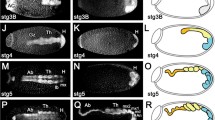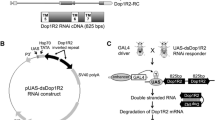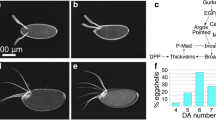Summary
In the insectDrosophila, formation of the puparium marks the onset of metamorphosis and serves as a useful marker for developmental progress. The cells of the adult remain diploid and divide during the larval stage while the larval cells become polytene and do not divide. We use a high dose of gamma-irradiation (10 krad) to selectively delete the imaginal lineage from the developing larvae ofDrosophila melanogaster. We find that animals depleted of imaginal cells including those of the imaginal brain pupariate only if the larval cells are allowed to mature, demonstrating that the larval cells harbor the primary developmental timer for this process. However, proliferating imaginal cells can exert a negative influence on the timing of pupariation.
Similar content being viewed by others
References
Arena V (1971) Ionizing radiation and life: An introduction to radiation biology and biological radiotracer methods. Mosby, St. Louis
Bodenstein D (1950) The postembryonic development ofDrosophila. In: Demerec M (ed) Biology ofDrosophila. Wiley, New York, pp 275–367
Borst DW, Bollenbacher WE, O'Connor JD, King DS, Fristrom JW (1974) Ecdysone levels during metamorphosis ofDrosophila melanogaster. Dev Biol 39:65–76
Bownes M (1975) A photographic study of development in the living embryo ofDrosophila melanogaster. J Embryol Exp Morphol 32:789–801
Brett WJ (1955) Persistant diurnal rhythmicity inDrosophila emergence. Ann Ent Soc Am 48:119–131
Bryant PJ (1987) Experimental and genetic analysis of growth and cell proliferation inDrosophila imaginal discs. In: Loomis WF (ed) Genetic regulation of development. 45th Ann Symp Soc Dev Biol, AR Liss, Inc, New York, pp 339–372
Bryant PJ, Levinson PY (1985) Intrinsic growth control in the imaginal primordia ofDrosophila, and the autonomous action of a lethal mutation causing overgrowth. Dev Biol 107:355–363
Bryant PJ, Schubiger G (1971) Giant and duplicated imaginal discs in a new lethal mutant ofDrosophila melanogaster. Dev Biol 24:233–263
Bryant PJ, Simpson P (1984) Intrinsic and extrinsic control of growth in developing organs. Quart Rev Biol 59:387–415
Campos-Ortega JC, Hartenstein V (1985) The embryonic development ofDrosophila melanogaster. Springer, Berlin Heidelberg New York Tokyo
Dewes E (1973) Regeneration in transplanted halves of male genital disks and its influences upon duration of development inEphestia kuhniella Z. Roux's Arch Dev Biol 172:349–354
Gateff E (1978) Malignant neoplasms of genetic origin inDrosophila melanogaster. Science 200:1448–1459
Grossfield J (1978) Non-sexual behavior ofDrosophila. In: Ashburner M, Wright TRF (eds) The genetics and biology ofDrosophila, vol 2b. Academic Press, London, pp 3–126
Hamburger V, Hamilton HL (1951) A series of normal stages in the development of the chick embryo. J Morphol 88:49–92
Haynie JL, Bryant PJ (1977) The effects of X-rays on the proliferation dynamics of cells in the imaginal wing disc ofDrosophila melanogaster. Roux's Arch Dev Biol 183:85–100
Heinrich VC, Pak MD, Gilbert LI (1987) Neural factors that stimulate ecdysteroid synthesis by the larval ring gland ofDrosophila melanogaster. J Comp Physiol B 157:543–549
James AA, Bryant PJ (1981) A quantitative study of cell death and mitotic inhibition in -irradiated imaginal wing discs ofDrosophila melanogaster. Radiation Res 87:552–564
Madhavan MM, Schneiderman HA (1977) Histological analysis of the dynamics of growth of imaginal discs and histoblast nests during the larval development ofDrosophila melanogaster. Roux's Arch Dev Biol 183:269–305
Nieuwkoop PD, Faber J (1967) Normal table ofXenopus laevis. 2nd ed. North-Holland, Amsterdam
Poodry CA (1975) Autonomous and non-autonomous cell death in the metamorphosis of the epidermis ofDrosophila. Roux's Arch Dev Biol 178:333–336
Poodry CA (1980) Epidermis: Morphology and development. In: Ashburner M, Wright TRF (eds) Genetics and biology ofDrosophila, vol 2. Academic Press, New York, pp 407–441
Rahn P (1972) Untersuchungen zur Entwicklung von Ganz- and Teilimplantaten der Flügelimaginalscheibe vonEphestia kühniella Z. Roux's Arch Dev Biol 170:48–72
Saunders DS (1982) Insect clocks. 2nd ed. Pergamon Press, Oxford
Shearn A, Rice T, Garen A, Gehring W (1971) Imaginal disc abnormalities in lethal mutants ofDrosophila. Proc Natl Acad Sci USA 68:2594–2598
Simpson P, Berreur P, Berreur-Bonnenfant (1980) The initiation of pupariation in Drosophila: Dependence on growth of the imaginal discs. J Embryol Exp Morphol 57:155–165
Steel CGH, Davey KG (1985) Integration in the insect endocrine system. In: Kerkut GA, Gilbert LI (eds) Comprehensive insect physiology, biochemistry, and pharmacology. Pergamon Press, New York, pp 1–35
Stewart M, Murphy C, Fristom JW (1972) The recovery and preliminary characterization of X-chromosome mutants affecting imaginal discs ofDrosophila melanogaster. Dev Biol 27:71–83
Szabad J, Bryant PJ (1982) The mode of action of “discless” mutations in Drosophila melanogaster. Dev Biol 93:240–256
Truman JW, Bate M (1988) Spatial and temporal patterns of neurogenesis in the central nervous system ofDrosophila melanogaster. Dev Biol 125:145–157
Wieschaus E, Nüsslein-Volhard (1986) Looking at Embryos In: Roberts DB (ed) Drosophila: a practical approach. IRL Press, Oxford, pp 197–227
Wigglesworth VB (1972) The principles of insect physiology. 7th ed Chapman and Hall, London
Woods DF, Bryant PJ (1989) Molecular cloning of the lethal(1)-discs large-1 oncogene ofDrosophila. Dev Biol 134:222–235
Zdarek J (1985) Regulation of pupariation in flies. In: Kerkut GA, Gilbert LI (eds) Comprehensive insect physiology, biochemistry, and pharmacology. Pergamon Press, New York, pp 301–333
Author information
Authors and Affiliations
Rights and permissions
About this article
Cite this article
Poodry, C.A., Woods, D.F. Control of the developmental timer forDrosophila pupariation. Roux's Arch Dev Biol 199, 219–227 (1990). https://doi.org/10.1007/BF01682081
Received:
Accepted:
Issue Date:
DOI: https://doi.org/10.1007/BF01682081




